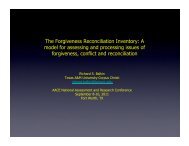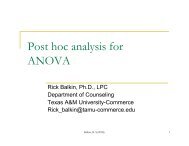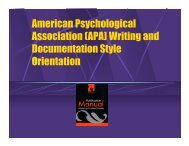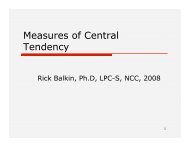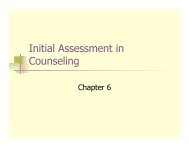notes
notes
notes
- No tags were found...
Create successful ePaper yourself
Turn your PDF publications into a flip-book with our unique Google optimized e-Paper software.
7/14/1012Appraisal of PersonalityChapter 10Personality Assessment Personality What is it? How can it be measured? Personality Assessment Clarifies client problems Helps select interventions Assists in treatment decisions Contributes to structure of counseling relationship345Personality Assessment (cont.) Informal personality assessments: Observation Interviewing Formal personality assessments: Structured personality instruments Projective techniquesInformal Assessment Techniques Observation: Most common method used Counselor biases? Reliability – unsystematic error Validity concerns Interviewing: Diagnostic v. descriptive Quality of questions? Reliability concerns Validity concernsStructured Personality Inventories Methods of constructing personality inventories: Content-related procedure Personality theory Empirical criterion keying1
87/14/10 Known as the Restructured Clinical Scales MMPI-2-RF has evolved from the Restructured Clinical Scales(published in 2008) Not intended as a replacement of MMPI-2 but as analternative 338 items = less time to complete 50 scales = more complex interpretation9NEO-PI-R Research suggests personality can best be described by 5factors: I – Extroversion (or Surgency) II – Agreeableness III – Conscientiousness IV – Neuroticism (or Emotional Stability) V – Openness to Experience (or Intellect) Factors appear to apply across diverse cultures.10 NEO-PI-R operationalizes these 5 factors of personality.NEO-PI-R (cont.) Form S contains is self-report form; 240 items. Form R is observer-report form of instrument; different formsfor men and women. Criticized on use for identifying pathology; normed on normaladults; based on common characteristics of personality, notpathology.11 Has potential to be used cross-culturally.Myers-Briggs Type Indicator (MBTI) Widely-used; based on Jungian theory, for individuals 14years and older. Typology instrument providing scores on 4 dichotomies,resulting in individuals being categorized into one of 16psychological types123
7/14/10psychological types12 Murphy-Meisgeir Type Indicator for Children (ages 7-12)MBTI (cont.) Dichotomies: Extroversion – Introversion Sensing – Intuition Thinking – Feeling Judging-Perceiving Preferences on the 4 continuums result in a 4-letter code,producing a personality type Criticisms: Research on whole type scores is ambiguous and wanting Concerns about constructs being measured and whetherthey are sufficient to describe the complexities and importantaspects of personality131415Other Standardized Personality Instruments Sixteen Personality Factor Questionnaire (16PF) Includes measures of 16 factors and 5 global factors Version also exists for adolescents Jackson Personality Inventory – Revised (JPI-R) 15 subscales organized into 5 higher-order clusters Psychometrically-sound and well-researchedLimitations of Standardized Personality Instruments Majority are self-report instruments. Clients are able to distort results: “fake” good or bad Risk of response sets To increase validity of profiles: Inform client of purpose of inventory and how results will beused Instruct client to answer each question honestly Ask them to focus on each of the questionsProjective Techniques Provide client with a relatively unstructured stimulus torespond to – examiner takes responses and interprets the4
7/14/1015 Provide client with a relatively unstructured stimulus torespond to – examiner takes responses and interprets themeaning. Psychoanalytic concept of projection – individuals’ tendencyto project their own drives, defenses, desires, and conflictsonto external situations and stimuli. Thought to uncover more of the client’s unconscious and,thus, provide an indication of the covert or latent traits. More difficult to “fake” responses161718Projective Techniques (cont.) Includes significant subjectivity in interpretation, and extensivetraining is needed to use these instruments. Categories: Associations Construction Completions Arrangement/selection ExpressionProjective Techniques (cont.) Association techniques: Rorschach Inkblot Test Construction techniques: Thematic Apperception Test (TAT) Completion techniques: Rotter Incomplete Sentences Blank, 2 nd ed. Rosenzweig Picture-Frustration StudyProjective Techniques (cont.) Arrangement/Selection techniques: Sandplay Other techniques involving play Expression techniques: Drawing techniques Draw-a-Person Test (D-A-P)195
7/14/101920 Draw-a-Person Test (D-A-P) House-Tree-Person (H-T-P) Kinetic Family Drawing (K-F-D)Projective Techniques (cont.) Strengths: More difficult to fake Can sometimes identify more complex themes andmultidimensional aspects of personality Can serve as an effective method of establishing rapport Helpful with children and nonverbal clients Limitations: Low reliability evidence More caution needed when interpreting results Meager validation information Lack of normative data Can be dangerous with untrained usersSelf-Concept Measures Debate and differing opinions on definition and characteristicsof self-concept Most measures relate to individuals’ evaluations of theirperformance or feelings about themselves Sometimes used to obtain information on client attributes atbeginning of counseling process21 Used to examine effect of counseling interventionsSelf-Concept Measures (cont.) Examples: Piers-Harris Children Self-Concept Scale, Second Edition Tennessee Self-Concept Scale – Second Edition (TSCS-2) Coopersmith Self-Esteem Inventories (CSEI)6




